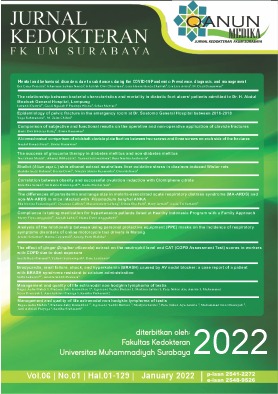Correlation between obesity and successful ovulation induction with Clomiphene citrate
Abstract
ABSTRACT
Ovulation induction with clomiphene citrate is a hormonal therapy for infertile women with impaired ovarian function caused by dysregulation of the hypothalamus and pituitary, affecting egg development and ovulation. Several factors, such as obesity, influence the success rate of treatment with clomiphene citrate. According to the Asia-Pacific classification, obesity was classified into two categories, obesity type I (25-29,9 kg/m2) and obesity type II (≥30 kg/m2). The success rate of ovulation induction with clomiphene citrate in obese infertile women at Graha Amerta Fertility Clinic in Dr. Soetomo General Hospital on July 2019 – July 2020 was about 22.8%. The research aimed to analyze the correlation between obesity with successful ovulation induction with clomiphene citrate. This research method was observational analytic research with a cross-sectional approach. The data were collected from medical records of infertile obese women who undergo ovulation induction with clomiphene citrate. According to inclusion criteria, the number of samples is 79 cycles of infertile obese women who undergo ovulation induction with clomiphene citrate. Data analysis using Chi-square test. The result showed that successful ovulation induction in obese type I was 17.7% and in obese type II was 5.1%. There was a correlation between obesity with successful ovulation induction with clomiphene citrate (p=0.009). In conclusion, there was a correlation between obesity with successful ovulation induction.
Keyword                   : ovulation induction, clomiphene citrate, obese
Correspondence       : sri-r-d@fk.unair.ac.idation induction.
Full text article
References
Aboul, W. M., Barghash, N. A., & Ali, M. (2004). Clinical, ultrasonographic and endocrine predictors of ovarian response to clomiphene citrate in normogonadotropic anovulatory infertility. Middle East Fertility Society. https://tspace.library.utoronto.ca/handle/1807/7458
Akpinar, F., Dilbaz, B., Cırık, D. A., Yilmaz, S., Kiykac, S., Karahanoglu, E., & Mollamahmutoglu, L. (2016). The significance of anthropometric and endocrine parameters in ovulation induction with clomiphene citrate in women with polycystic ovary syndrome. Saudi Medical Journal, 37(11), 1272–1275. https://doi.org/10.15537/smj.2016.11.15006
Armstrong, A. B., Hoeldtke, N., Wiess, T. E., Tuttle, R. M., & Jones, R. E. (1996). Metabolic parameters that predict response to clomiphene citrate in obese oligo-ovulatory women. Military Medicine, 161(12), 732–734. https://doi.org/10.1093/milmed/161.12.732
Balen, A. H. (2013). Ovulation induction in the management of anovulatory polycystic ovary syndrome. Molecular and Cellular Endocrinology, 373(1), 77–82. https://doi.org/https://doi.org/10.1016/j.mce.2012.10.008
Brown J, F. C. B. J. B. C., & Hughes, E. (2009). Clomiphene and antiâ€oestrogens for ovulation induction in PCOS. Cochrane Database of Systematic Reviews, 4. https://doi.org/10.1002/14651858.CD002249.pub4
Ellakwa, H. E., Sanad, Z. F., Hamza, H. A., Emara, M. A., & Elsayed, M. A. (2016). Predictors of patient responses to ovulation induction with clomiphene citrate in patients with polycystic ovary syndrome experiencing infertility. International Journal of Gynecology and Obstetrics, 133(1), 59–63. https://doi.org/10.1016/j.ijgo.2015.09.008
Fritz, M. A., & Speroff, L. (2012). Clinical gynecologic endocrinology and infertility. lippincott Williams & Wilkins.
Harzif, A. K., Santawi, V. P. A., & Wijaya, S. (2019). Discrepancy in perception of infertility and attitude towards treatment options: Indonesian urban and rural area. Reproductive Health, 16(1), 126. https://doi.org/10.1186/s12978-019-0792-8
Imani, B., Eijkemans, M. J. C., de Jong, F. H., Payne, N. N., Bouchard, P., Giudice, L. C., & Fauser, B. C. J. M. (2000). Free Androgen Index and Leptin Are the Most Prominent Endocrine Predictors of Ovarian Response during Clomiphene Citrate Induction of Ovulation in Normogonadotropic Oligoamenorrheic Infertility1. The Journal of Clinical Endocrinology & Metabolism, 85(2), 676–682. https://doi.org/10.1210/jcem.85.2.6356
Imani, B., Eijkemans, M. J. C., te Velde, E. R., Habbema, J. D. F., & Fauser, B. C. J. M. (1999). Predictors of Chances to Conceive in Ovulatory Patients during Clomiphene Citrate Induction of Ovulation in Normogonadotropic Oligoamenorrheic Infertility1. The Journal of Clinical Endocrinology & Metabolism, 84(5), 1617–1622. https://doi.org/10.1210/jcem.84.5.5705
Johnson, N. P., Bontekoe, S., & Stewart, A. W. (2011). Analysis of factors predicting success of metformin and clomiphene treatment for women with infertility owing to PCOS-related ovulation dysfunction in a randomised controlled trial. Australian and New Zealand Journal of Obstetrics and Gynaecology, 51(3), 252–256. https://doi.org/10.1111/j.1479-828X.2011.01295.x
Legro, R. S., Dodson, W. C., Kris-Etherton, P. M., Kunselman, A. R., Stetter, C. M., Williams, N. I., Gnatuk, C. L., Estes, S. J., Fleming, J., Allison, K. C., Sarwer, D. B., Coutifaris, C., & Dokras, A. (2015). Randomized controlled trial of preconception interventions in infertile women with polycystic ovary syndrome. Journal of Clinical Endocrinology and Metabolism, 100(11), 4048–4058. https://doi.org/10.1210/jc.2015-2778
Lindheim, S. R., Glenn, T. L., Smith, M. C., & Gagneux, P. (2018). Ovulation Induction for the General Gynecologist. Journal of Obstetrics and Gynecology of India, 68(4), 242–252. https://doi.org/10.1007/s13224-018-1130-8
Lindsay, T. J., & Vitrikas, K. R. (2015). Evaluation and treatment of infertility. American Family Physician, 91(5), 308–314.
Mesiano S, Jones EE. Chapter 55: The female reproductive system. In: Boron WF, Boulpaep EL, editors. Medical physiology. 3rd ed. Philadelphia: Elsevier; 2017.
Moschos, S., Chan, J. L., & Mantzoros, C. S. (2002). Leptin and reproduction: A review. Fertility and Sterility, 77(3), 433–444. https://doi.org/10.1016/S0015-0282(01)03010-2
Nelson, S. M., & Fleming, R. (2007). Obesity and reproduction: Impact and interventions. In Current Opinion in Obstetrics and Gynecology (Vol. 19, Issue 4, pp. 384–389). https://doi.org/10.1097/GCO.0b013e32825e1d70
Nishida, C., Barba, C., Cavalli-Sforza, T., Cutter, J., Deurenberg, P., Darnton-Hill, I., Deurenberg-Yap, M., Gill, T., James, P., Ko, G., Kosulwat, V., Kumanyika, S., Kurpad, A., Mascie-Taylor, N., Moon, H. K., Nakadomo, F., Nishida, C., Noor, M. I., Reddy, K. S., … Zimmet, P. (2004). Appropriate body-mass index for Asian populations and its implications for policy and intervention strategies. The Lancet, 363(9403), 157–163. https://doi.org/10.1016/S0140-6736(03)15268-3
Oliveira, F. R. de, & Lemos, C. N. C. D. (2010). Obesidade e reprodução. Femina. http://files.bvs.br/upload/S/0100-7254/2010/v38n5/a004.pdf
Rosenfield, R. L., & Ehrmann, D. A. (2016). The Pathogenesis of Polycystic Ovary Syndrome (PCOS): The hypothesis of PCOS as functional ovarian hyperandrogenism revisited. In Endocrine Reviews (Vol. 37, Issue 5, pp. 467–520). Endocrine Society. https://doi.org/10.1210/er.2015-1104
World Health Organization. (2020). Obesity and overweight. https://www.who.int/news-room/fact-sheets/detail/obesity-and-overweight
Authors

Qanun Medika by FK UM Surabaya is liscence under Lisensi Creative Commons Atribusi 4.0 Internasional.

